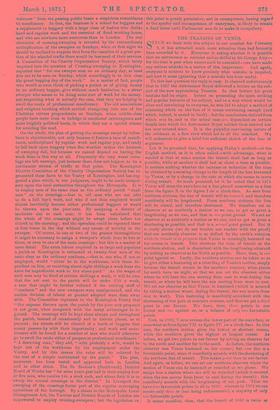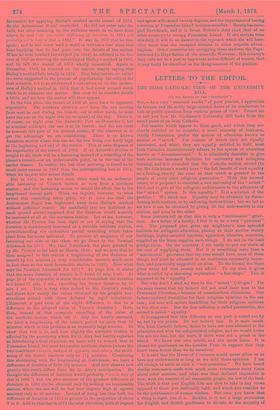THE TRANSITS OF VENUS.
SINCE we dealt with this subject in our number for February 8, it has attracted much more attention than had formerly been accorded to it. Everyone is asking whether it is possible that an astronomer so eminent and so skilful as Sir George Airy— for the time is past when names need be concealed—can have made any serious mistake in a matter of this importance. And again, everyone is anxious to know precisely what mistake is imputed, and how it arose (granting that a mistake has been made).
To this last question the reply is easy. It chanced unfortunately
that in 1857 the Astronomer Royal delivered a lecture on the sub- ject of the now approaching Transits. In that lecture his great mistake had its origin. Intent on presenting the more striking and popular features of his subject, and in a way which would be clear and convincing to everyone, he was led to adopt a method of reasoning which on the face of it seems convincing enough (and which, indeed, is sound in itself) ; but the conclusions derived from which may be, and in the actual case are, dependent on certain details into which the Astronomer Royal neither then entered nor has ever entered since. It is the palpably convincing nature of the evidence at a first view which led to all the mischief. We will endeavour to give a brief but sufficient sketch of the line of argument.
Let it be premised that, for applying Halley's method—or the English method, as it is often called—with advantage, what is wanted is that at some station the transit shall last as long as possible, while at another it shall last as short a time as possible. It matters nothing whether the increase or reduction of the time be obtained by a seeming change in the length of the line traversed
by Venus, or by a change in the rate at which she seems to move during transit. So much premised, let it be noted that in 1871 Venus will cross the sun's face on a line placed somewhat as a line from the figure X to the figure 1 on a clock-face. As seen from northern stations, the line of transit will be lowered, and therefore manifestly will be lengthened. From southern stations, the line will be raised, and therefore shortened. We therefore set an observer at as northerly a station as we can, to get as great a lengthening as we can, and that is one point gained. We set an observer at as southerly a station as we can, and so get as great a shortening as possible, and that is a second point gained. But it is easily shown (we do not trouble our readers with the proof) that our northerly observer is so shifted by the earth's rotation while the transit is in progress that Venus is seemingly hastened on her course in transit. This shortens the time of transit at the northern station, and is discordant with the lengthening obtained by setting an observer as far North as possible. Here, then, is one point against us. Lastly, the southern station can be taken so as to give either a hastening or a retarding of Venus's motion, simply because the transit occurs in the southern summer, when places far south have no night, so that we can set the observer either where he will have the sun moving from east to west during the transit, or where he will have the sun moving from west to east. We set our observer so that Venus is hastened (which is secured by taking a station where, during the transit, the sun moves from east to west). This hastening is manifestly accordant with the shortening of her path at southern stations, and thus we get a third point in our favour. We have, then, three points in our favour and one against us, or a balance of only two favourable points.
Now, in 1882, Venus crosses the lower part of the sun's face, or somewhat as from figure VII. to figure IV. on a clock-face. In this case, the northern etation gives the lowest or shortest course, while the southern gives the highest or longest course. As before, we get two points in our favour by setting an observer far to the north and another far to the south. As before, the northern observer sees Venus hastened on her course; but now this is a favourable point, since it manifestly accords with the shortening of the northern line of transit. This makes point three in our favour. And again, as before, we can set our southern observer where the motion of Venus can be hastened or retarded as we please. We assign him a station where she will be retarded (which is secured when the sun moves from !west to east during the transit) : this manifestly accords with the lengthening of her path. Thus we havefour favourable points in all in 1882; whereas in 1874 we can secure only three or (one being unfavourable), a majority of only two favourable points.
It seems manifest, then, that the transit of 1882 is twice as
favourable for applying Halley's method as the transit of 1874. So the Astronomer Royal concluded. He did not enter into de- tails, but after summing up the evidence much as we have done above, he said "the observable difference of duration in 1874 will probably not be half of that in 1882." It was in 1857 that he thus spoke; and he has never said a word or written a line aince.that
time implying that he had gone into the details of the matter. When he next touched the subject (in 1864) he referred to the lec- ture of 1857 as showing the suitability of Halley's method in 1882, and he left the transit of 1874 wholly unnoticed. Again in December, 1868, he touched on the matter, simply saying that Halley's method fails totally in 1874. That fatal lecture, or rather the error suggested in the process of popularising the subject for that occasion, led to so established a conviction as to the useless- ness of Halley's method in 1874, that it had never seemed worth while to re-examine the matter. But now let us consider details a little, and see how the matter will then appear.
In the first place, the transit of 1882 at once loses its apparent superiority. The southern observer must have the sun moving
from west to east during the transit,—or in other words, he must have the sun on the night side (so to speak) of the sky. There is, of course, no night near the Antarctic Pole on December 6, but at nominal midnight the sun is at its lowest ; and the sun must be towards this part of his diurnal course, if the observer is to get the advantage we are considering. There is no known
Antarctic station where this can be, the sun being also fairly high at the beginning and end of the transit. This at once disposes of the superiority of the transit of 1882. If an Antarctic station is
sought at all, there will be a hastening instead of a retarding of the planet's transit,—or an unfavourable point, as in the case of the earlier transit. In reality, the loss thus accruing is found to be much more serious in 1882 than the corresponding loss in 1874, when we inquire into actual details.
But in 1874, as we have seen, there must be an unfavour- able hastening of Venus's motion as seen from a northern station ; and this hastening seems to cancel the effect due to the lengthened transit-path. When we inquire, however, to what extent this cancelling takes place, we at once see that the Astronomer Royal was frightened away from Halley's method without sufficient reason. He manifestly (see the italicised re- mark quoted above) supposed that the duration would scarcely be increased at all at the northern station. Let us see, however, whether Mr. Proctor has been right or not in saying that the duration is considerably increased at a suitable northern station, notwithstanding the undoubted partial cancelling which takes place from the cause indicated. To prevent all suspicion of our favouring one side or the other, we go direct to the Nautical
Almanack for 1874. We take Nertchinsk, the place pointed to by Mr. Proctor so far back as March, 1869; and we note that be
then assigned to this station a lengthening of the duration of transit by 15i minutes (a very considerable amount, much more in fact than at the most favourable station in 1882). Now what says the Nautical Almanack for 1874? At page 434, it states that the mean duration of transit is 3 hours 42 min. 2 sec. At page 20 of the appendix, it states that at Nertchinsk the duration is 3 hours 57 mm. 6 sec., exceeding the former duration by 15 min. 4 sec. This is very close indeed to Mr. Proctor's result, and shows how nearly the values obtained by his graphic con- structions accord with those deduced by rigid calculation. (Moreover, a part even of the slight difference is due to a difference in the adopted value of Venus's diameter.) Here, then, instead of that complete cancelling of the value of the northern station which Sir G. Airy too hastily assumed, we have a lengthening of the transit period by more than 15 minutes, which in this problem is an unusually large amount. To
show that this is so, and how slightly the northern station is affected by the peculiarity which Sir G. Airy had hastily regarded OS introducing a fatal objection, we have only to remark that at Possession Island, the most favourable southern station (where the two conditions conspire, instead of opposing each other), the short-
ening of the transit amounts only to 17i minutes. Combining this shortening with the lengthening at Nertchinsk, we have a difference of duration of fully 32i minutes. And now observe how
greatly this result differs from Sir G. Airy's anticipation ! He thought the difference of duration would probably "not be half of that in 1882 "; but his own estimate of the greatest difference of
duration in 1882 (to be obtained only by seeking an inaccessible station, where the sun will be but four degrees high at egress)
amounts only to 28 minutes. Instead of being less than half, the difference of duration in 1874 is greater in the proportion of about 7 to 6. Add to this that in 1874 the solar elevation, both at ingress
and egress will exceed twenty degrees, and the importance of having a station at Possession Island becomes manifest. Russia has occu- pied Nertchinsk, and it is Great Britain's duty (and that of no other country) to occupy Possession Island. If she shrinks from this duty, it will be no answer to the reproach which she will here- after incur that she occupied stations in other respects advan- tageous. Other countries are occupying these stations, the Pape- lotte and La Hue Sainte of the scientific Waterloo ; this country's duty calls her to a post so important and so difficult of tenure, that it may fairly be described as the Hougoumount of the position.



































 Previous page
Previous page